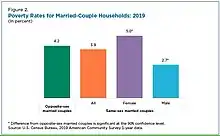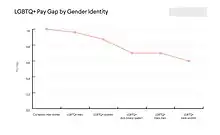Gay wage gap
The gay wage gap is the pay gap between homosexuals and heterosexuals. Men in same-sex marriages have a significantly higher median household income than opposite-sex married couples: $123,600 and $96,930, respectively.[1] Individual gay men earn 10% more than straight men with similar education, experience and job profiles,[2][3] and individual gay men who are married have a significantly higher median income than heterosexual married men.[4] Because of the Gender pay gap, same-sex female couples make less than heterosexual married couples.[5] For women, same-sex married couples earn roughly the same as opposite-sex married couples, which tends to fluctuate by the year.[1][4]
Overall, same-sex married couples in the US have a 27% higher median household income than heterosexual married couples.[6] This difference is due to the higher earnings men make over women.

The economic advantages gay men experience in the US is most striking in poverty rates. Among married households, 2.7% of gay men live in poverty, while 4.2% of opposite-sex married couples live in poverty. Without men's salaries to account for, 5% of same-sex female couples live in poverty.[5]
US Census data has found that the wage advantages same-gender couples have over different-gender couples—being dual earners, having higher education and living in urban areas—did not benefit same-gender female couples in the way way they did male couples.[7]
Phenomenon
Full-time employed gay men earn, on average, 10 percent more than straight men.
Kirk Snyder, professor at the USC business-school, noted that gay people are better entrepreneurs. Gay managers have a 25% higher level of employee engagement.[8] The National Transgender Discrimination Survey[9] reported, that trans people are up to four times as likely to earn less than $10,000 and twice as likely to be unemployed due to discrimination.[8] In the 2013–2015 National Health Surveys analysed by Christopher Carpenter and Samuel Eppink, they found that gay, full-time employed men made, on average, 10% more than similarly employed straight men even when controlling for various other factors.[10]
Wage discrimination by country
Netherlands
Gay men are economically advantaged in the Netherlands. Same-sex male couples have the highest combined income from work or business, the so-called primary income. Their average gross annual income is 15 thousand euros higher compared to opposite-sex couples. The incomes of lesbian and straight couples are more or less the same.[11]
Germany
Taking into account age, education, and industry, gay men earn less than heterosexuals even though they tend to be better educated than the average population.[12][13][14]
Australia
An Australian study[15] has shown that gay men earn 13% less than their straight counterparts. Meanwhile, lesbians earn 13% more than straight women. La Nauze, economist at University of Melbourne, noted: "There are grounds for concern that workers in Australia, particularly gay men, are discriminated against because of their sexual orientation."[16]
United States
A study of the 2013–15 National Health Interview Surveys found that gay, full-time employed men made, on average, 10% more than similarly employed straight men. The same study showed that lesbians received a pay premium of 9%. Bisexual men and women earned less than both gay and straight counterparts.[17]
Wage discrimination by orientation
Lesbian women
Lesbian women make a median of 1.4% more than heterosexual women, but make 25.6% less than heterosexual men.[18] Women who are between the ages of 18 and 44, 29% of bisexual women and 23% of lesbian women are experiencing poverty, compared to 21% of heterosexual women.[19] But, lesbians still earn less than the regular household income of a heterosexual couple because of the gender wage gap. As a result, lesbian couples/households are more likely to live in poverty than heterosexual couples/households.[20] Thus, gay women in relationships are disadvantaged because their income is totally composed of women's salaries.
Men earn more than women in most occupations, and this inequality plays out regardless of sexual orientation. In fact, in Badgett's 2009 review, some studies showed that while lesbians earned more than heterosexual women, they made less than straight and gay men.
Gay men
Until recently it was thought that gay men made a median of 18.4% less than compared to straight men.[18] A recent study has showed that in the US full-time employed Gay men now earn 10% more than their heterosexual counterparts.[21] 20% of gay men and 25% of bisexual men between the ages of 18 and 44 live in or below the poverty level, unlike the 15% of heterosexual men who are not.[19]
Transgender individuals
The highest pay gap is for trans women, since they receive $0.60 for every $1 a straight cisgender man receives.[22] However, the pay gap for trans men is a bit lower since they receive $0.70 for every $1 a straight cisgender man gets.[22] This gives us proof that gender influences wages.
Transgender adults are nearly 4 times as likely to have a household income of under $10,000 per year.[19]
See also
Sources
- Bureau, US Census. "Census Bureau Implements Improved Measurement of Same-Sex Couples". Census.gov. Retrieved 2023-07-31.
- Carpenter, Kitt (2017-12-04). "Gay Men Used to Earn Less than Straight Men; Now They Earn More". Harvard Business Review. ISSN 0017-8012. Retrieved 2023-07-31.
- Carpenter, Kitt (2017-12-04). "Gay Men Used to Earn Less than Straight Men; Now They Earn More". Harvard Business Review. ISSN 0017-8012. Retrieved 2023-08-15.
- Barroso, Amanda; Fry, Richard. "On some demographic measures, people in same-sex marriages differ from those in opposite-sex marriages". Pew Research Center. Retrieved 2023-07-31.
- "Examining the economic status of same-gender relationship households". Brookings. Retrieved 2023-08-04.
- thisisloyal.com, Loyal |. "Demographics of Married and Unmarried Same-Sex Couples". Williams Institute. Retrieved 2023-08-04.
- Branigin, Anne (2022-02-03). "Same-gender female couples make $30,000 less a year than their male counterparts". Washington Post. ISSN 0190-8286. Retrieved 2023-08-04.
- Rivas, Jorge. "The gay pay gap: Gays get paid less, lesbians earn more". Splinter. Retrieved 2017-08-31.
- Grant, Jaime M. "Injustice at Every Turn" (PDF). National Transgender Discrimination Survey. Archived from the original (PDF) on 2015-05-06. Retrieved 2017-08-31.
- "Gay men now earn more than straight men in the US". Retrieved 2019-07-17.
- Netherlands, Statistics (2019-10-11). "Gay male couples have the highest incomes". Statistics Netherlands. Retrieved 2023-08-15.
- "Arbeitsmarkt: Schwule verdienen weniger als Heterosexuelle". Die Zeit (in German). 2017-08-31. ISSN 0044-2070. Retrieved 2017-08-31.
- Holzki, Larissa (2017-08-31). "Schwule Männer verdienen weniger". sueddeutsche.de (in German). ISSN 0174-4917. Retrieved 2017-08-31.
- "Schwule verdienen weniger als Heteromänner – aber warum? – Mannschaft Magazin". Mannschaft Magazin (in German). 2017-09-01. Retrieved 2017-09-01.
- Wade, Matt (2015-02-28). "The gay pay gap: men earn less, but women earn more". The Sydney Morning Herald. Retrieved 2017-08-31.
- "Untitled | Employment Discrimination | Homosexuality". Scribd. Retrieved 2017-08-31.
- "Gay men now earn more than straight men in the US". Retrieved 2019-07-17.
- "Ignoring LGBT individuals allows the gay wage gap to continue". realchangenews.org. Retrieved 2019-05-05.
- "Lesbian, Gay, Bisexual and Transgender Persons & Socioeconomic Status". www.apa.org. American Psychological Association. Retrieved 2019-05-05.
- "The Impact of Wage Equality on Sexual Orientation Poverty Gaps". Williams Institute. 2015-06-02. Retrieved 2019-05-05.
- Carpenter, Christopher S.; Eppink, Samuel T. (2017). "Does It Get Better? Recent Estimates of Sexual Orientation and Earnings in the United States". Southern Economic Journal. 84 (2): 426–441. doi:10.1002/soej.12233.
- Viladrich, M (2023-06-19). "LGBTQ+ community: Wage gap and workplace challenges". TalentUp. Retrieved 2023-08-14.
